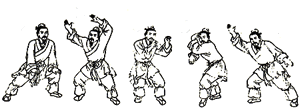Movement Description of Big Bear Turns from Side to Side
Face
towards N12.
Bent the upper torso down, flexing forward, keep the back straight and head up.
Move the upper torso slowly towards the right side of E3. Try to remain bent forward until you reach E3.
Keep your hands on your hips throughout this exercise.
Gradually lift the head and torso until you are upright and the face and chest are facing towards E3.
Your right elbow should be pointing towards S6 and your left elbow pointing towards N12.
Gently turn the head only to the left and look towards N12.
Gently bring the head back to face towards E3, the whole body is in an upright posture.
Bend forward at the waist and draw the head and torso downward towards E3.
Bent the upper torso down, flexing forward, keep the back straight and head up.
Move the upper torso slowly towards the right side of E3. Try to remain bent forward until you reach E3.
Keep your hands on your hips throughout this exercise.
Gradually lift the head and torso until you are upright and the face and chest are facing towards E3.
Your right elbow should be pointing towards S6 and your left elbow pointing towards N12.
Gently turn the head only to the left and look towards N12.
Gently bring the head back to face towards E3, the whole body is in an upright posture.
Bend forward at the waist and draw the head and torso downward towards E3.
Move the upper body, flexed
forward, from right side to the left side for 180 degrees, moving from E3 to W9.
Gradually lift the head and torso until you are upright, and the face and chest are facing towards W9.
Your right elbow should be pointing towards N12 and your left elbow pointing towards S6.
Gently turn the head only to the right and look towards N12.
Gently turn the head only back to the left, and W9.
Bend forward at the waist and draw the head and torso downward towards W9.
Move the upper body, flexed forward, from the left side to the right side for 180 degrees, moving from W9 to E3.
Repeat the movement sequence from side to side, 3 to 8 eight repetitions.
Gradually lift the head and torso until you are upright, and the face and chest are facing towards W9.
Your right elbow should be pointing towards N12 and your left elbow pointing towards S6.
Gently turn the head only to the right and look towards N12.
Gently turn the head only back to the left, and W9.
Bend forward at the waist and draw the head and torso downward towards W9.
Move the upper body, flexed forward, from the left side to the right side for 180 degrees, moving from W9 to E3.
Repeat the movement sequence from side to side, 3 to 8 eight repetitions.
Breathe freely, comfortably, and
deeply during this exercise.
Return to Bear Spirit Posture or
Wu Ji Stance. Bear Frolic Qigong Exercise Set
Eight Animals Frolics Mind/Body Fitness Practices (Chi Kung) by Mike Garofalo
The webpages for the eight specific animals will also have photographs of me or others doing these exercises. There are also five, eight or twelve animals in Shaolin Kung Fu, Ba Gua Zhang, Taijiquan, and Xing Yi Quan. Movements or postures called a "crane" or "hawk" or "rooster" are found in most of these mind-body internal arts.
Chinese exercises recommended for improving fitness, maintaining good health, overcoming diseases, increasing energy and vitality, contributing to good mental health, and improving one's chances for longevity have a very long documented history going back to as early as 160 BCE in the Daoyin Tu.
Repost from June 4, 2013

No comments:
Post a Comment